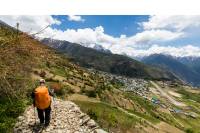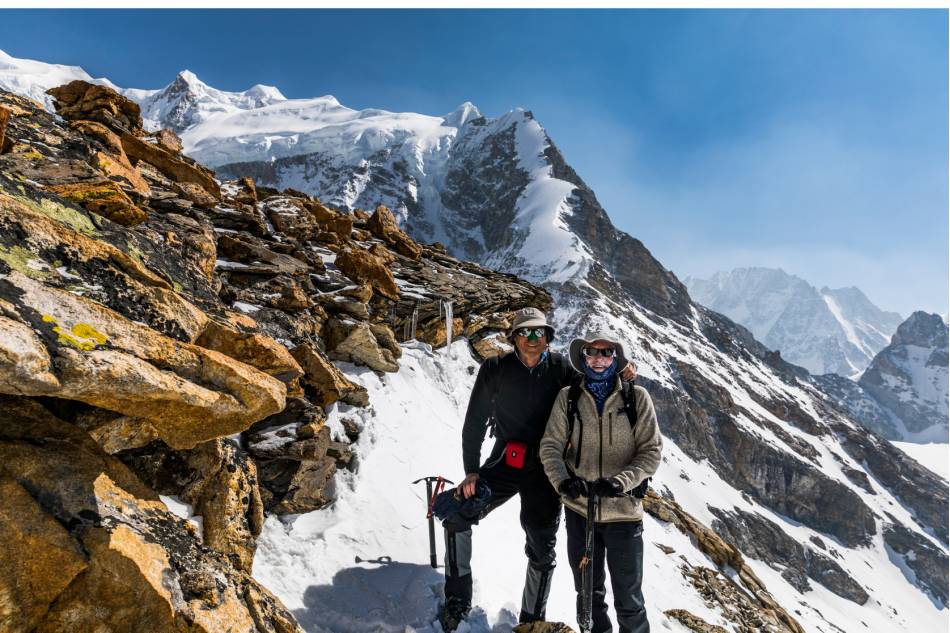Blog home / Top 10 Training and Preparation Tips for Trekking
Are you considering embarking on a trek but are not sure if you’re mentally or physically up to it? We hear you! Sometimes a trekking holiday can be a little daunting, especially if you’ve never been on one before. If you take a simple, step by step approach you will be well on your way to being fit for your trekking adventure. We’ve consulted our expert staff and leaders to compile our top trek training and preparation tips—so you’ll feel ready to take on a rewarding and life-changing trekking adventure.
Preparing Yourself Physically
1. Do exercise you enjoy
The more you enjoy something, the more motivated you will be to do it! If you really love swimming, rock climbing, Zumba, or yoga for example, then add it to your exercise plan. If you’re having fun, you won’t even notice your training!
Another thing to consider is joining a walking group. Walking with a group comes with great benefits like making new friends, and it also helps provide motivation to get out and train. There are many walking groups on Meetup and Facebook that can connect you with like-minded walking buddies.
Group sports like soccer and volleyball, in which you train once or twice a week then compete on the weekends, are a great way to get in shape, as are individual sports like tennis and squash.
2. Mix up the terrain and weather conditions
It’s important you read through your trips notes to get an idea of the type of terrain you’ll be walking on during your trek. Try to do some walking that mimics the conditions you will experience on your trek as closely as you can. Also don’t forget that hills are your friend! The more you practice on hills, the more prepared you’ll be for your trek, especially if you’re trekking in the mountains. The same goes for stairs. Find some stairs at your local park and do a couple of sets each week.
To prepare yourself even more, try running or walking on grass. Running or walking on sand is especially beneficial, through it can be frustrating.
3. Fuel your body well
Your energy requirements will increase while trekking so it’s important to fuel your body well. Try to eat small, frequent meals while training to maintain your energy levels. If you are going for a long training walk, it’s essential to eat a well-rounded healthy breakfast and to drink plenty of water. The guides will provide you with trail mix and other snacks, so you won’t need to worry about bringing these on your trip.

Preparing Yourself Mentally
4. Remember to pace yourself
If it’s your first time trekking don’t be put off by the thought of training! It’s normal to feel a little nervous. Just remember it’s not a race. Go at a pace that’s comfortable for you so you can relax and soak up the surroundings along the way. A guide will always walk towards the back of the group, so don’t feel like you need to keep up with the fastest walker. At the end of the day, trekking is about putting one foot in front of the other at a pace you are most comfortable with.
5. Consistency and persistence is key
Aim to keep up a consistent amount of exercise each week, especially during the weeks leading up to your trek. It’s a good idea to schedule exercise sessions at the same time every week and to fit them into your daily schedule. If you struggle to find the time to exercise, try incorporating it into your everyday routine—like walking to work or running during your lunch break.
Don’t forget to start your training early, instead of leaving it to the last minute. The earlier your start your trek training the better. The fitter you are, the more you’ll get out of your trip. When it comes to training, try not to feel overwhelmed. Training doesn’t need to be over-complicated.
Also, remove as many barriers as possible, so you can’t come up with excuses not to train. For example, organise your gym clothes the night before, set reminders on your phone and keep a workout calendar.
Many people write plans for training down so they can tick off the activity once it’s complete. There a certain sense of accomplishment in being able to scratch things off a to-do list.
6. Understand your trip grade
It’s important to understand your trip grading, which is listed in your trip notes, so that you know what type of trekking you’ll face on your trip. The majority of our treks are rated from introductory (grade 3) to moderate (grade 5), with some challenging treks graded a 6. Understanding your trip itinerary will help shape your training sessions and give you guidelines on how much training you should do each week leading up to your trip.
There are many factors that contribute to the difficultly of your trek, including the length, terrain, altitude, and weather conditions. These grading factors do not take into account personal abilities or experience, so if you have any queries relating to your fitness do not hesitate to contact us.
You can mix up your training to make it fun—say three days on, one day off. Bike riding, jogging, stairs in the local park, the rowing machine, and swimming are all good options—anything that will improve your endurance. Of course, nothing beats bush walking with a heavy pack—up the hill and down the hill. Then repeat.

Preparing Your Gear
7. Consider using walking poles
We’d recommend you consider using trekking poles for your walk. Studies have shown that walking with poles can reduce the pressure strain on the opposite leg by approximately 20 percent (Dr G Neureuther, 1981). Furthermore, while walking on an incline, poles reduce the body weight carried by the legs by approximately 8 kilograms (5 kilos on flat terrain).
Using poles also allows trekkers to lengthen their stride, putting less strain on their knees (American College of Sports Medicine Journal, 2001). Though it still may be an exhausting day on the trail, trekking poles can certainly make the long days easier and more enjoyable.
8. Practice walking with your backpack
The majority of our treks are fully supported, meaning you’ll only need to carry a day pack while the rest of your luggage being transferred to your campsite or hotel. You’ll most likely be carrying up to 5 kilos in your day pack, including items such as water, snacks, spare clothing, and a camera.
It’s important you choose a backpack that’s comfortable and includes back support and adjustable chest and waist straps so that you are able to position the bag correctly on your body. You may also consider getting one with a bladder so you can easily sip water on the go. Make sure you use your bag as part of your training so you can ensure it’s as comfortable as possible before your trek.
One suggestion is to fill your backpack with clothes and a couple of water bottles so it weighs approximately 7 kilos and hit the hills, stairs, the local park—anywhere you can walk where there’s a gradient. Remember it is just as important training going down as it is going up as we use different muscles for each.
9. Find the right footwear
Your shoes could make or break your trip! No other piece of equipment can impact your enjoyment of your trek more than your boots, so investing in comfortable trekking boots is highly recommended. We advise going to a gear shop to be fitted by an expert who will talk you through the range of boots on offer and find the best boot to suit your foot type.
We recommend a full boot with ankle support and a sturdy Vibram sole on all of our treks that are grade 3 and above. While quality boots cost more, it’s worth the investment when you consider how long your boots will last and how much they can impact your trip. Try to go shopping for your boots in the afternoon when your feet have expanded slightly—to ensure you get the correct size.
Once you’ve bought your boots make sure you wear them as much as possible! They might feel a bit uncomfortable and stiff at first, but the more your wear them, the more they will mould to your foot. Start with short walks and build up to longer ones. It might take some time to wear them in, but its better you get blisters now rather than on your trip. We’ll talk more about blisters next!
10. Blisters can be avoided!
After concerns about fitness, blisters are the second biggest worry for trekkers. Blisters are created from friction, heat, and swelling. When it comes to blisters—prevention is essential and is much better than trying to cure them once you’ve got them. Here are some of our top tips for preventing blisters:
Make sure your shoes fit properly—if they are too tight or too loose, they will often cause issues.
Quality socks are essential—many trekkers prefer to wear a liner sock under a heavier hiking sock to wick moisture and keep the foot dry. Try a merino wool or polypropylene liner in cold conditions or a Coolmax liner for warm to hot conditions.
Keep dry—using foot powder with the right sock can really help prevent moisture from gathering.
Lubricant—Body Glide is great for reducing friction. Many runners and walkers use it on their feet as well as other friction points on their body to prevent chafing.
Blister blocks and second skin—if you have ‘hot spots’ that are prone to blisters, try applying these items prior to your walk. They can also be used for protection and cushioning after a blister has formed.
Wrapping and taping—tape any pressure points or hot spots each day with athletic tape or moleskin. Make sure there are no wrinkles in the tape that might rub. While a trek may seem daunting, particularly if it’s your first time, if you take the time to prepare yourself mentally and physically, you’ll be well on your way to being ready to take on the challenge. If you have any concerns about preparation and training, our experts are here to guide you.
The last piece of advice is to make sure you follow your dreams and do a trip if you want to. No one ever gained anything by spending an extra hour in the office or in front of a computer. At the end of your life you’ll look back and it will be the things you didn’t do that will stand out more than the things that you did do.